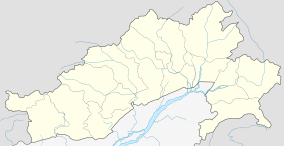Mishmi Hills
| Mishmi Hills | |
|---|---|
 Mishmi Hills  Mishmi Hills Location of Mishmi hills on the map of Arunachal Pradesh | |
| Highest point | |
| Peak | (India) |
| Coordinates | 28°22′10″N 95°48′11″E / 28.36944°N 95.80306°ECoordinates: 28°22′10″N 95°48′11″E / 28.36944°N 95.80306°E |
| Geography | |
| Country | India |
| District | Upper Siang, West Siang & Dibang Valley |
Mishmi Hills are on the Northeastern tip of India, in central Arunachal Pradesh.[1] They are also a part of Shan-Malaysia plate.[2] It is recorded that their height is 5140 ft.[3] The hills are a southward extension of the Great Himalayan ranges and its northern and eastern parts touch China. It is divided into three geographical distributions.
These hills occur at the junction of Northeastern Himalaya and Indo-Burma ranges. The Himalayan arc takes a sharp turn and meets Indo-Burma ranges. The rocks of eastern lesser Himalaya and the central crystallines appear to be largely attenuated and truncated in Mishmi Hills.[4]
Introduction
Geomorphically, Mishmi Hills are divided into 2 sections – the flood plains of tributaries of Brahmaputra river and the Arunachal Himalayas consisting of snow-capped mountains, lower Himalayan ranges and Shivalik ranges. This hilly area is characterised by steeply sloping landform, sub-tropical evergreen forest and high rainfall. Much of these hills fall in the Dibang valley.[5]
Administration
Mishmi Hills was declared as a district after its bifurcation of Sadiya Frontier Tract in 1948. Again in 1951, the plains area were transferred to the administrative jurisdiction of Assam.[6] In 1952, the headquarters was shifted from Sadiya to Tezu. When North-East Frontier Agency (NEFA) in 1954 it became Lohit Frontier Division.
Flora and fauna
Mishmi Hills experience heavy rainfall with pre-monsoon showers from March. The humidity and rainfall is about 90%. There are about 6000 plant species, 100 mammal species and about 700 bird species. There are also a large number of butterflies and other insects. Temperate conifers, sub-alpine woody shrubs, alpine meadows, bamboos and grasslands are found in this region. Tiger, common leopard, clouded leopard, snow leopard, golden cat, jungle cat, marbled cat and the leopard cat are found. The endangered red panda is seen in the northern reaches and the hoolock gibbon is abundant. One of the most unusual ungulates found here is the Mishmi takin. Serow, musk deer and the Himalayan black bear are also found.[5]
Bird life
There are about 680 bird species.[5] Some of them are Sclater's monal, Blyth's and Temminck's tragopan, chestnut-breasted partridge, rufous-necked hornbill, pale-capped pigeon, Ward's trogon, dark-sided thrush, green and purple cochoa, rusty-bellied and Gould's shortwing, beautiful nuthatch, rusty-throated and wedge-billed wren babbler, fire-tailed myzornis, at least four parrotbill species, black-headed greenfinch, scarlet finch and grey-headed bullfinch.[7]
Tourism
Temperatures ranges from below 5 °C in winter to 38 °C in summer.[8]
References
- ↑ Hamlet Bareh (2001). Encyclopaedia of North-East India. Mittal Publications. pp. 182–. ISBN 978-81-7099-788-7. Retrieved 27 July 2012.
- ↑ Abani K. Bhagabati; Bimal Kumar Kar (1999). Survey of Research in Geography on North East India, 1970–1990. Regency Publications. pp. 13–. ISBN 978-81-86030-89-9. Retrieved 27 July 2012.
- ↑ Anwaruddin Choudhury (1 January 2003). The Mammals Of Arunachal Pradesh. Regency Publications. pp. 12–. ISBN 978-81-87498-80-3. Retrieved 28 July 2012.
- ↑ J. R. Kayal (6 June 2008). Microearthquake Seismology and Seismotectonics of South Asia. Springer. pp. 273–. ISBN 978-1-4020-8179-8. Retrieved 28 July 2012.
- 1 2 3 "Mishmi Hills, Arunachal Pradesh".
- ↑ Pratap Chandra Swain (1 January 2008). Panchayati Raj. APH Publishing. pp. 66–. ISBN 978-81-313-0379-5. Retrieved 28 July 2012.
- ↑ http://www.kolkatabirds.com/mishmi/mishmiclist.htm
- ↑ http://www.ecotrailsindia.com/destination.aspx?destination=Mishmi%20Hills